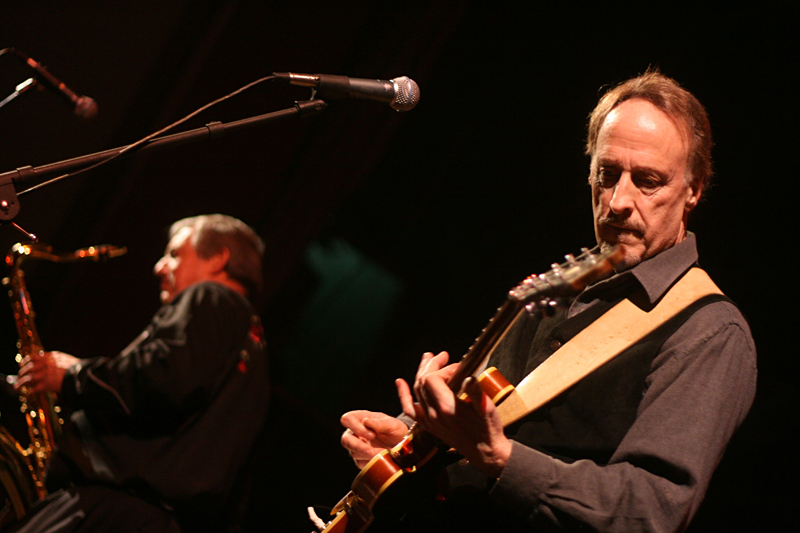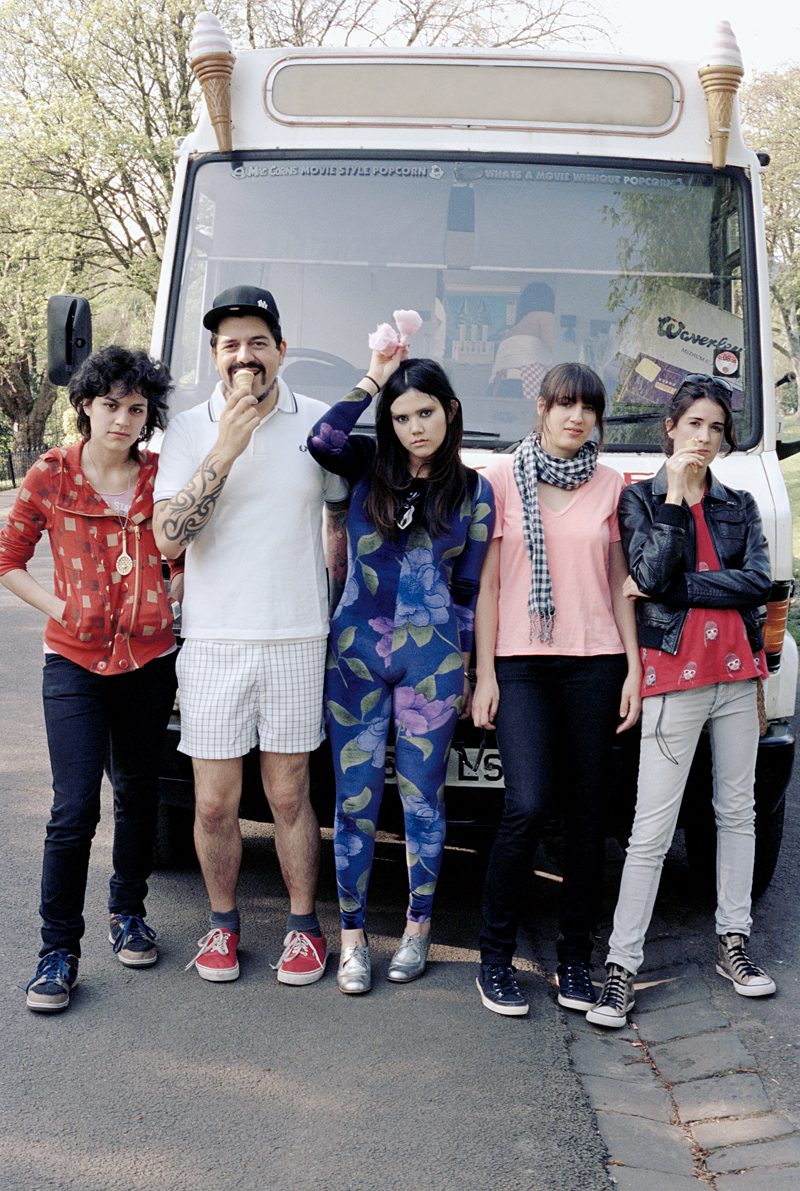Tacoma’s most influential garage band finally returns to play its hometown.
Tacoma’s 1960s garage-rock heroes, the Sonics, kept mysteriously mum for 40 years. But for the past four and a half, they’ve made quite a racket, melting faces at packed overseas venues with pyroclastic blasts of “Psycho,” “Boss Hoss,” and “Strychnine.”
“In the European rock community, they’re really big,” says Howlin’ Pelle Almqvist, whose chart-topping Swedish garage-punk band, the Hives, owes quite a bit to the Sonics. “They’ll play the biggest festivals, and they’re considered sort of the inventors of the garage-rock genre.”
Local fans have waited patiently as their comeback trail has wound through Europe, Australia, and Japan. Finally that patience will pay off, as the enigmatic Sonics headline their first hometown gig since the Johnson administration Friday night at Tacoma’s Pantages Theater.
“It’s just something we probably should have done a long time ago,” Sonics guitarist Larry Parypa admits. “That’s where it all started.”
The Sonics have played a few U.S. dates since they stormed back into action at Brooklyn’s Cavestomp festival in November 2007. They headlined at Seattle’s Paramount Theatre on Halloween 2008 and Olympia’s Capitol Theater two years later on New Year’s Eve. But Parypa guesses the last Tacoma gig took place sometime in 1966, much to the chagrin of the hometown faithful.
As a result, Parypa and company are no longer household names back where it all began. Mention “the Sonics,” and the average Tacoman is more likely to curse Howard Schultz than recall the howling fury of “Cinderella.” But the band is a great source of civic pride among veteran South Sound scenesters.
The Fabulous Wailers ushered in the Original Northwest Sound with “Tall Cool One” in 1959, and the Ventures sold millions more records. But it was the Sonics who emerged as the most emulated Tacoma garage gods. The classic lineup jelled in 1963, with Jerry Roslie on keys and lead vocals, Rob Lind on saxophone, Bob Bennett on drums, and brothers Larry and Andy Parypa on guitar and bass, respectively. In the early days, they honed their skills twice monthly at Tacoma’s Red Carpet, a teen dance club located on South Tacoma Way until it went dark in 1971. The live album Busy Body!!! Live in Tacoma 1964 documents one rowdy night there.
“Friday nights, the line was around the block,” Lind recalls. “It was about 108 degrees in there, and people were sweatin’, unable to move on the dance floor.” He adds, “It’s actually where we wrote ‘Psycho.’ We actually wrote it there after a show.”
By 1964, the Sonics’ infectious, raw sound had drawn the attention of Etiquette Records, the local imprint owned by the Wailers’ Kent Morrill and Buck Ormsby. They went into the studio with limited cash and archaic recording gear. Many cuts were rushed in one or two takes—a process that, ironically, may have made them sound better.
” ‘The Witch’ was written to be slower,” Lind says. “Maybe we were nervous kids or something, but it came out much faster. We went to Larry’s dad’s house out in Bremerton and laid out and listened to the dub that we had, and we thought we had totally blown it. We paid for that session with our own money, and we thought, ‘Oh, god! This is horrible.’ ” He laughs. “Next thing you know, it’s being requested at all the high-school dances, and we bludgeoned Pat O’Day into putting it on KJR’s playlist.”
The Sonics cracked conservative local airwaves despite concerns about “devil music.” But the band fell apart before it could gain much traction outside the Northwest. Roslie left first, then Bennett defected to Merrilee and the Turnabouts. Lind got drafted into the Armed Forces, while Andy Parypa wound up selling the moniker to Randy Hiatt, who had taken over for Roslie on keys, and local singer Jim Brady. They kept Jim Brady & the Sonics going until 1980. But little other than the name connected that band to the previous incarnation.
“The days of hard rock and roll and 4/4 music were totally gone,” says Lind. “They were doing stuff like Los Lobos.”
The Sonics spent the next four decades working day jobs, largely oblivious to the fact that they’d made a lasting impression. Fans were left with a few watershed recordings—Here Are the Sonics, Boom, and Introducing the Sonics (ironically released third, by Jerden, in 1966)—and the compilations that followed. Jini Dellaccio’s striking black-and-white cover portraits kept the Sonics forever young and savage.
“It’s like they weren’t real,” said Owen Atkins, singer/guitarist for Tacoma’s Fucking Eagles (whose band shares DNA with the Sonics: Beyond the influence of ’60s garage-rock on its aesthetic, backup singer Kathlyn Lind Neal is Rob Lind’s niece). Atkins learned to play guitar listening to reissues of Sonics albums in the ’80s, but didn’t realize they were hometown heroes until he read it in The Rocket. “This is around the same time I’m learning about punk rock,” he says, “and discovering things like the Melvins and Soundgarden and realizing there is this whole continuum of honest, loud music.”
The Hives’ Almqvist caught the Sonics bug when he was 16, after a friend handed him a copy of the retrospective Psycho-Sonic. “It sounded like the perfect music to me, like I’d found home,” the swaggering Swede singer recalled. “I was into ’50s rock ‘n’ roll and ’70s punk. This seemed to bridge the gap.”
His was among many bands that feel the Sonics were ahead of their time. Kurt Cobain dropped their name in interviews; Pearl Jam and Bruce Springsteen mentioned them during local tour stops. Lind actually got to thank the Boss in person: A retired commercial pilot, he once flew Springsteen cross-country after the Grammys.
The Sonics’ revamp of Richard Berry’s doo-wop cut “Have Love, Will Travel” has drawn special attention. The band recorded it as an afterthought back in the ’60s. “We didn’t know it was really good,” says Lind. But Land Rover did, and used it to push Jeeps in a 2005 TV spot.
The Black Keys paid tribute, too, recording their own version for their 2003 album, Thickfreakness. During the duo’s May tour stop at KeyArena, singer/guitarist Dan Auerbach also cited the Sonics’ “Shot Down” as inspiration for “Girl Is on My Mind.” (“I heard the [Black Keys’] name before, but I didn’t know who they were,” says Roslie, who, with Larry Parypa and Ormsby, the band’s manager, were invited backstage.)
The Sonics remained largely oblivious to the fuss for years. By the early ’80s, Parypa had noticed a few mentions in magazines. But he was skeptical when Ormsby returned from a trip to Europe insisting there was enough interest to tour there. “We didn’t quite believe it,” Parypa says. “So everything was dormant until we started getting calls from Cavestomp, trying to encourage us to play over in New York City.”
All five original band members were involved in jam sessions which commenced a year before the band agreed to play the festival. But Bennett has only appeared at the Seattle show; he lives in Honolulu where he works as a car sales manager, making it difficult for him to him to tour and rehearse. And while Andy Parypa lives in Seattle, he hates to fly. So the new rhythm section consists of drummer Ricky Lynn Johnson and bassist Freddie Dennis (a veteran of regional rock acts Freddie & the Screamers, the Liverpool Five, and the Kingsmen, who splits lead vocal duties with Roslie).
In 2010, the new lineup went into the studio with renowned punk producer Jack Endino (Nirvana, Mudhoney) to record a new EP called 8. It includes four new cuts: “Cheap Shades,” “Vampire’s Kiss,” “Bad Attitude,” and “Don’t Back Down.”
Larry Parypa says there are sketches for eight to 10 more songs for the next full-length album. Roslie adds, “We’re passing on some jobs in Europe because we want to get something out there that we really like.”
“We didn’t really accomplish what we wanted with the EP,” Lind says. “It sounded a little bit too polished. So I think if we go back into the studio, we’ll try to capture that energy and rawness like we did on that first album.” Laughing, he adds, “One take, that’s good enough.”






